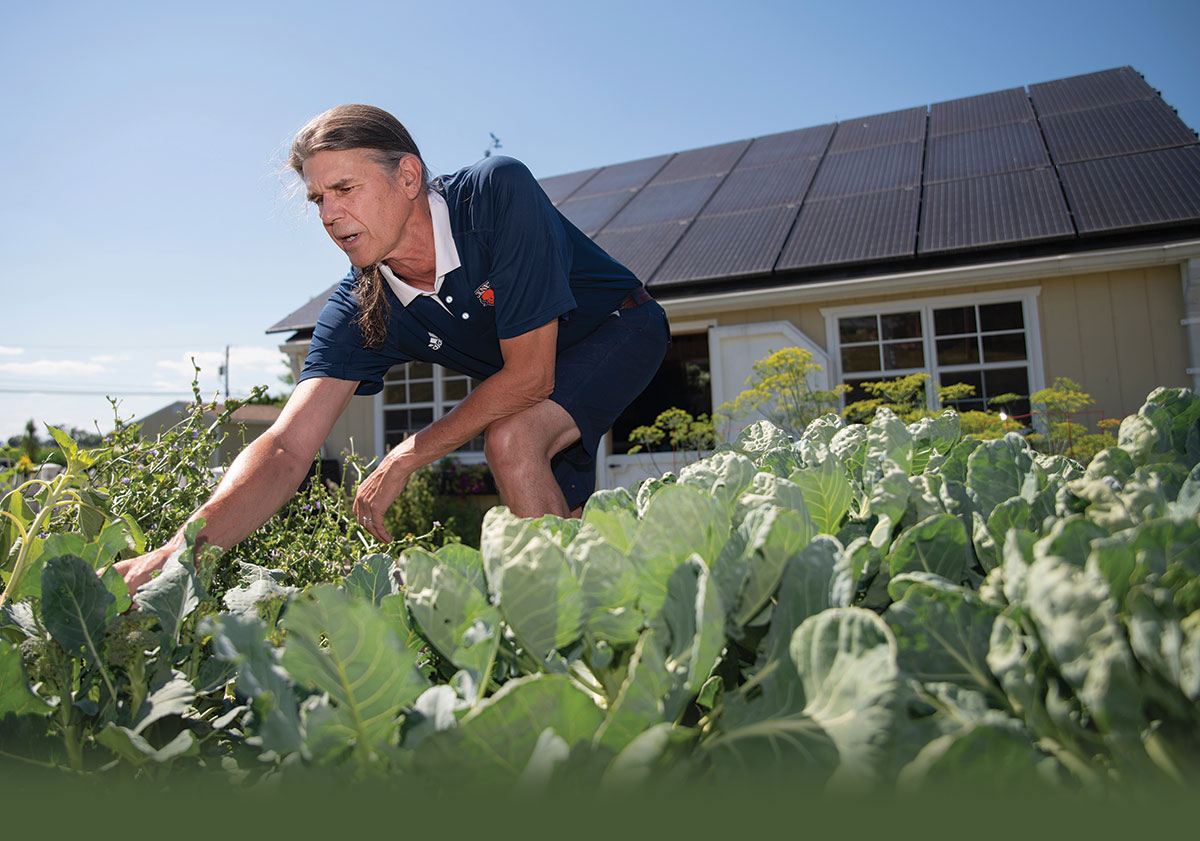
Experiment’


Experiment’
hen electrical engineering professor Peter Jansson moved to Lewisburg five years ago and went house hunting with his wife, Megan, there were a few idiosyncratic items on their must-have list: a clear southern exposure and the ability to clock the hours of sunlight the house gets before buying. An environmentalist to the core, Jansson saw in his new abode an opportunity for solar-powered sustainable living that he’d long awaited but couldn’t execute at his last home, which was surrounded by beautiful but sun-obscuring trees.
At a glance, the 12-year-old, four-bedroom two-story a mile from campus that the Janssons settled into doesn’t scream sustainable homestead. At a little over 3,000 square feet, its ambiance is a bit more McMansion than hobbit home. But it contains a high-tech secret — a power system that’s rarely been built at the residential level. With the opportunity he’d long awaited finally in sight, Jansson didn’t just slap his 24-panel, six-kilowatt solar array on a roof and call it a day; he made his home into its own microelectrical grid — a safe and self-sustaining system that generates and distributes its own power — as well as a teaching and research station for what just might be the future of sustainable living.
He also planted a garden, because Jansson didn’t just want to see how much he could curb his power consumption. His goal, as he explains it, was to find out “how sustainable people could become and still save money doing it.”
They also added flowers and shrubs, such as milkweed and choke berries, that attract pollinators or rejuvenate the soil, and planted peach, pear, cherry, apple and almond trees. In the backyard fronting the shed that Jansson built to hold up his solar panels (giving them 95 percent solar exposure) is a series of raised beds sprouting an array of veggies as diverse as any grocery-store produce section. In the high season, Jansson estimates he gets as much as a third of his nutrients from this garden, grown organically and as cheaply and sustainably as possible, using methods modeled on the Bucknell- supported Lewisburg Community Garden.
Other sustainable features are a compost pile and rain barrels, and he has plans to install a water well driven by the solar array for irrigation in dry spells. Eventually Jansson, now 61, hopes to reach an equilibrium where the garden becomes totally self-sustaining. “Everything’s a living experiment for me,” Jansson says, “because I’m not a farmer.”
But Jansson is not just experimenting; he’s sharing what he’s doing with whomever will listen. He regularly brings his students on tours of his home, inviting them to take a head of cauliflower or lettuce when they leave, and he’s starting a blog to document his efforts as a model for others.
One of those students was Phil Diefenderfer ’13, M’15, who helped Jansson transform his abode into a research station and classroom, making real the dream Jansson had envisioned some two decades earlier. That’s when he left a lucrative career as a manager and executive at a New Jersey electric company to pursue a Ph.D. at Cambridge University, seeking “novel ways to generate power.”
“The project allowed me to apply everything I had learned while at Bucknell to address a technological challenge,” says Diefenderfer, who now designs energy grids for the U.S. Department of Defense.
As new students picked up the project where Diefenderfer left off, Jansson began to think about ways to overcome the volatility of renewables such as wind and sunshine. One solution is to store the power they produce using batteries, but this tactic has drawbacks, including the massive environmental toll extracted in battery manufacturing. But what if the home itself was the battery?
The idea, says Jansson, is to store energy virtually by aligning a home’s peak renewable production, which occurs around noon, with its energy use. With the help of engineering students and Professor Philip Asare, electrical & computer engineering, Jansson has programmed his home to crank the AC or heat in the afternoon, when his power is free or cheap. This allows him to store thermal energy in the walls, furniture and other surfaces, saving it for the later peak consumption hours around dinnertime.
Jansson’s method of pairing smart-home technology with on-site electrical generation and an independent grid is almost unheard of in a residential setting. But he’s happy to report it’s working. In most warmer months Jansson pays only a $14 connection fee to the electric company, and even during last winter’s sustained cold snap, his bill never topped $300. Not bad when you consider that those figures also include his commuting expenses — he drives a Chevy Volt electric car.
“The results of our summer experiments are quite good in terms of saving money,” says Sikder, who came to Bucknell from Bangladesh in part for the opportunity to work with Jansson. “With this system you’re often not drawing power from the main grid, which means that you are not leaving a carbon footprint in our environment.”
1. Start with a home energy audit. “You’ll find out where your main users are, and where to start investing. Some can be done online.”
2. Switch to LED lightbulbs. “Get the yellowish ones. People who think they’re averse to LEDs are often buying the cheapest, brightest ones that aren’t good indoors.”
3. Dump the old heat pump. “Consider upgrading your heating system to a really efficient one, because it’s usually one of your biggest energy consumers.”
4. Energy Star is a must. “Some appliances use 100 or more kilowatt hours a month, while there are refrigerators and freezers on the market that use 100 kilowatt hours a year.”
5. Ghost hunt for “phantom loads.” “Almost all electronic devices like televisions, computers and cable boxes can use power even if they’re turned off. Put them on an energy-saving plug, or a power strip you can flip on and off.” — Matt Hughes
Everyone might not have the desire or the means to achieve what Jansson has in his home, but he’s adamant that everyone can make their lives incrementally more sustainable without much investment or effort.
“If anybody says, ‘I’m not a gardener, I’m not a farmer, I’m not a whatever,’ ” he says, steering the conversation back to his garden, “I want to say, ‘Sure you can. One of these things that I’ve tried might work for you. Anybody can put in an apple tree. And if you like apples, why don’t you have an apple tree?’ ”
